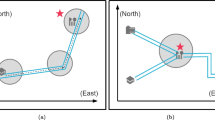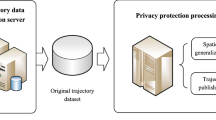Abstract
Continuous publication of statistics collected from various location-based applications may compromise users’ privacy as the statistics could be procured from users’ private data. Differential Privacy (DP) is a new privacy notion that offers a strong privacy guarantee to all users who participate in the statistics. However, the existing DP mechanism for continuous publication of location statistics provides a privacy guarantee with the assumption that the data-points of users stream at consecutive timestamps are independent. In reality, users’ data-points may be temporally correlated, resulting in more privacy leakage due to an inadequate supply of privacy budget to the timestamps where the data-points are correlated. In this paper, we present a reformulated differential privacy definition to quantify the impact of temporal correlation on privacy leakage. Then, we introduce a privacy budget allocation method for allocating an adequate amount of privacy budget to each successive timestamps under the protection of differential privacy. Our solution adopts w-event privacy for continuously releasing statistics over infinite streams. The main idea is to check the dissimilarity between statistics at each timestamp and decide whether to publish current statistics or last release statistics. Finally, we evaluate the data utility of our proposed method by presenting experimental results for real and synthetic data sets.













Similar content being viewed by others
References
Schneider MJ, Jagpal S, Gupta S, Li S, Yan Y (2017) Protecting customer privacy when marketing with second-party data. Int J Res Mark 34:593–603
Lane ND, Mohammod M, Lin M, Yang X, Lu H, Ali S, Doryab A, Berke E, Choudhury T, Campbell A (2011) Bewell: a smartphone application to monitor, model and promote wellbeing. In: 5th International ICST conference on pervasive computing technologies for healthcare, pp 23–26
Thiagarajan A, Ravindranath L, LaCurts K, Madden S, Balakrishnan H, Toledo S, Eriksson J (2009) VTrack: accurate, energy-aware road traffic delay estimation using mobile phones. In: Proceedings of the 7th ACM conference on embedded networked sensor systems. ACM, pp 85–98
Guha S, Reznichenko A, Tang K, Haddadi H, Francis P (2009) Serving Ads from localhost for performance, privacy, and profit. HotNets
Malathi D, Logesh R, Subramaniyaswamy V, Vijayakumar V, Sangaiah AK (2019) Hybrid reasoning-based privacy-aware disease prediction support system. Comput Electr Eng 73:114–127
Chow C-Y, Mokbel MF (2011) Trajectory privacy in location-based services and data publication. ACM Sigkdd Explor Newslett 13(1):19–29
Dong Y, Pi D (2018) Novel privacy-preserving algorithm based on frequent path for trajectory data publishing. Knowl-Based Syst 148:55–65
Aggarwal CC, Philip SY (2008) A general survey of privacy-preserving data mining models and algorithms. In: Privacy-preserving data mining. Springer, pp 11–52
Dwork C (2011) Differential privacy. Encyclopedia of cryptography and security. Springer, pp 338–340
Sweeney L (2002) k-anonymity: a model for protecting privacy. International Journal of Uncertainty, Fuzziness and Knowledge-Based Systems. World Scientific, pp 557–570
Hemkumar D, Ravichandra S, Somayajulu DVLN (2020) Impact of prior knowledge on privacy leakage in trajectory data publishing. Engineering Science and Technology, an International Journal. Elsevier
Fan L, Xiong L, Sunderam V (2013) Fast: differentially private real-time aggregate monitor with filtering and adaptive sampling. In: Proceedings of the 2013 ACM SIGMOD international conference on management of data. ACM, pp 1065–1068
Kellaris G, Papadopoulos S, Xiao X, Papadias D (2014) Differentially private event sequences over infinite streams. Proceedings of the VLDB Endowment, 1155–1166
Cao Y, Yoshikawa M, Xiao Y, Xiong L (2018) Quantifying differential privacy in continuous data release under temporal correlations. IEEE Trans Knowl Data Eng 31(7):1281–1295
Dwork C (2010) Differential privacy in new settings. In: Proceedings of the twenty-first annual ACM-SIAM symposium on discrete algorithm. SIAM, pp 174–183
Fan L, Xiong L (2012) Real-time aggregate monitoring with differential privacy. In: Proceedings of the 21st ACM international conference on information and knowledge management. ACM, pp 2169–2173
Zheng Y, Zhang L, Xie X, Ma W-Y (2009) Mining interesting locations and travel sequences from gps trajectories. In: Proceedings of the 18th international conference on world wide web. ACM, pp 791–800
Yuan J, Zheng Y, Xie X, Sun G (2011) Driving with knowledge from the physical world. In: Proceedings of the 17th ACM SIGKDD international conference on knowledge discovery and data mining. ACM, pp 316–324
Yuan J, Zheng Y, Zhang C, Xie W, Xie X, Sun G, Huang Y (2010) T-drive: driving directions based on taxi trajectories. In: Proceedings of the 18th SIGSPATIAL international conference on advances in geographic information systems. ACM, pp 99– 108
Cocchia A (2014) Smart and digital city: a systematic literature review. In: Smart city. Springer, pp 13–43
Mohammed N, Fung B, Debbabi M (2010) Preserving privacy and utility in rfid data publishing
Chai T, Draxler RR (2014) Root mean square error (RMSE) or mean absolute error (MAE)?–Arguments against avoiding RMSE in the literature. Geoscientific model development. Copernicus GmbH, pp 1247–1250
Dwork C, Naor M, Pitassi T, Rothblum GN (2010) Differential privacy under continual observation. In: Proceedings of the forty-second ACM symposium on theory of computing, pp 715– 724
Cao Y, Yoshikawa M (2016) Differentially private real-time data publishing over infinite trajectory streams. IEICE Transactions on Information and Systems, pp 163–175
Li H, Xiong L, Jiang X, Liu J (2015) Differentially private histogram publication for dynamic datasets: an adaptive sampling approach. In: Proceedings of the 24th ACM international on conference on information and knowledge management. ACM, pp 1001–1010
Acs G, Castelluccia C (2014) A case study: privacy preserving release of spatio-temporal density in paris. In: Proceedings of the 20th ACM SIGKDD international conference on knowledge discovery and data mining. ACM, pp 1679–1688
Xiao Y, Xiong L, Fan L, Goryczka S (2012) DPCube: differentially private histogram release through multidimensional partitioning. arXiv:1202.5358
Chan T-HH, Chan ES, Song D (2011) Private and continual release of statistics. ACM Transactions on information and system security (TISSEC). ACM
Bolot J, Fawaz N, Muthukrishnan S, Nikolov A, Taft N (2013) Private decayed predicate sums on streams. In: Proceedings of the 16th international conference on database theory. ACM, pp 284–295
Fan L, Bonomi L, Xiong L, Sunderam V (2014) Monitoring web browsing behavior with differential privacy. In: Proceedings of the 23rd international conference on world wide web. ACM, pp 177–188
Mir D, Muthukrishnan S, Nikolov A, Wright RN (2011) Pan-private algorithms via statistics on sketches. In: Proceedings of the thirtieth ACM SIGMOD-SIGACT-SIGART symposium on principles of database systems. ACM, pp 37–48
Jiang K, Shao D, Bressan S, Kister T, Tan K-L (2013) Publishing trajectories with differential privacy guarantees. In: Proceedings of the 25th International conference on scientific and statistical database management, pp 1–12
Xiao Y, Xiong L (2015) Protecting locations with differential privacy under temporal correlations. In: Proceedings of the 22nd ACM SIGSAC conference on computer and communications security. ACM, pp 1298–1309
Kifer D, Machanavajjhal A (2011) No free lunch in data privacy. In: Proceedings of the 2011 ACM SIGMOD international conference on management of data. ACM, pp 193–204
Kifer D, Machanavajjhala A (2012) A rigorous and customizable framework for privacy. In: Proceedings of the 31st ACM SIGMOD-SIGACT-SIGAI symposium on principles of database systems. ACM, pp 77–88
Song S, Wang Y, Chaudhuri K (2017) Pufferfish privacy mechanisms for correlated data. In: Proceedings of the 2017 ACM international conference on management of data. ACM, pp 1291–1306
Yang B, Sato I, Nakagawa H (2015) Bayesian differential privacy on correlated data. In: Proceedings of the 2015 ACM SIGMOD international conference on management of data. ACM, pp 747–762
Liu C, Chakraborty S, Mittal P (2016) Dependence makes you vulnberable: differential privacy under dependent tuples. In: NDSS, pp 21–24
Zhu T, Xiong P, Li G, Zhou W (2014) Correlated differential privacy: hiding information in non-IID data set. IEEE Transactions on Information Forensics and Security. IEEE, pp 229–242
Xiaotong W, Wu T, Maqbool K, Qiang N, Wanchun D (2017) Game theory based correlated privacy preserving analysis in big data. IEEE Transactions on Big Data. IEEE
Cao Y, Yoshikawa M (2015) Differentially private real-time data release over infinite trajectory streams. In: 2015 16th IEEE international conference on mobile data management. IEEE, pp 68–73
Ma Z, Zhang T, Liu X, Li X, Ren K (2019) Real-time privacy-preserving data release over vehicle trajectory. IEEE Trans Veh Technol 68(8):8091–8102
Author information
Authors and Affiliations
Corresponding author
Additional information
Publisher’s note
Springer Nature remains neutral with regard to jurisdictional claims in published maps and institutional affiliations.
This article belongs to the Topical Collection: Special Issue on Privacy-Preserving Computing
Guest Editors: Kaiping Xue, Zhe Liu, Haojin Zhu, Miao Pan and David S.L. Wei
Appendix:
Appendix:
Theorem 3
Prove that
.
Proof
Sub-mechanism \({\mathscr{M}}^{2}\) allocates a privacy budgets per timestamps in exponential decreasing fashion i.e., (𝜖/8, 𝜖/16, 𝜖/32,...). Then LHS is,
We can rewrite
Let assume that 𝜖 = 1
By mathematical induction: Basis: n = 1
Inductive step: Assume true for n = p
Prove true for n = p + 1
□
Rights and permissions
About this article
Cite this article
Hemkumar, D., Ravichandra, S. & Somayajulu, D.V.L.N. Impact of data correlation on privacy budget allocation in continuous publication of location statistics. Peer-to-Peer Netw. Appl. 14, 1650–1665 (2021). https://doi.org/10.1007/s12083-021-01078-6
Received:
Accepted:
Published:
Issue Date:
DOI: https://doi.org/10.1007/s12083-021-01078-6




